Slow Motion Change-up Animations
Are you struggling with your change up? One of the most common problems with change-up performance is poor hand position. Poor hand position can lead to a number of undesirable results, but particularly if your change-up is too fast, this is the post for you. We’ll take a closer look at two of the most popular change-up styles and analyze how the hand position around the circle differs from the fastball.
What Makes a Change-up Go Too Fast
If you can’t seem to take enough speed off of your change-up, chances are it’s spinning too much or spinning in the wrong direction, depending on which type of change-up you’re trying to throw. Correct hand position through the throw zone is key to achieving the right spin. The tricky part is that getting your hand in the right position for a change-up involves forcibly altering the hand’s natural path. This can be challenging for a lot of pitchers.
I’m going to use slow-motion animations and still frames from a video to illustrate the hand position for each of two popular change-ups: the push change and the flip change. One of our high school pitchers was kind enough to demonstrate both!
The Push Change
Now before you all freak out, this change-up goes by TONS of different names. You may have heard it referred to as the push, circle, horseshoe, palm, or something else. This is a change-up that does not spin or spins very little, similar to a knuckleball in baseball. In this case though, it’s not held with the fingertips and bent knuckles; typically the ball is suctioned deep into the palm and then popped out of the hand with a relatively still wrist.
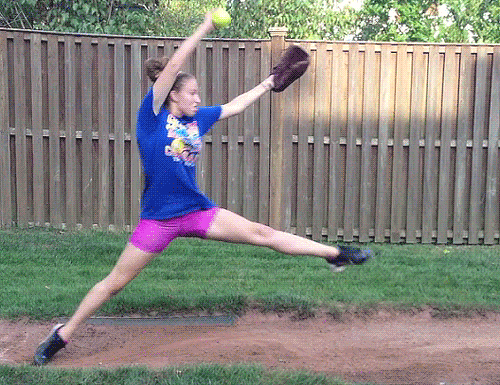
This pitcher is using a circle grip to throw her push change:
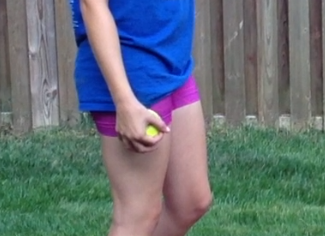
The ball is in her palm, and her thumb and pointer finger are relaxed into a circle shape in the middle of one of the horseshoes created by the seams. This is not the only way to hold a push change, but we find it tends to help take off speed.
The key with hand position here is from the time the arm reaches an angle parallel to the ground as it’s about to enter the throw zone, the circle remains on top:
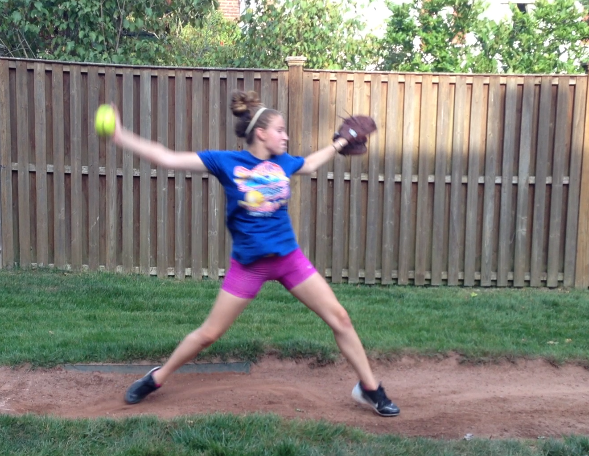
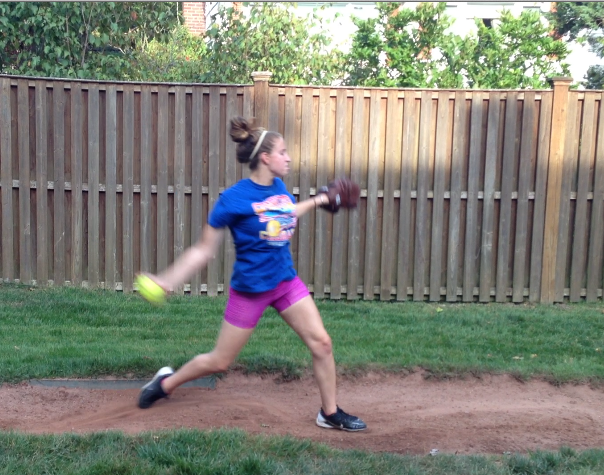
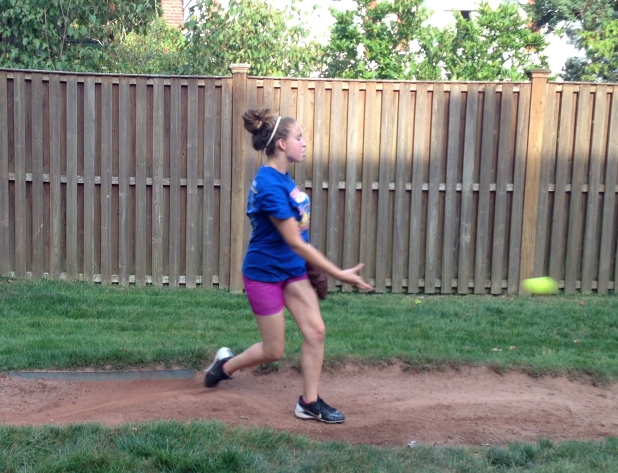
Then the fingers spread to open the hand wide, but the wrist doesn’t really move. You can see in the animation that she doesn’t whip or snap; she just pushes the ball levelly though the throw zone, almost like sliding a drink down a bar. The palm grip and the lack of snap enables you to move your arm just as fast as the fastball but release the ball with much less speed.
The Flip Change
The flip change is kind of like an opposite fastball; it spins with 4-seam rotation backwards as it’s floating forward. You can hold it like your fastball.
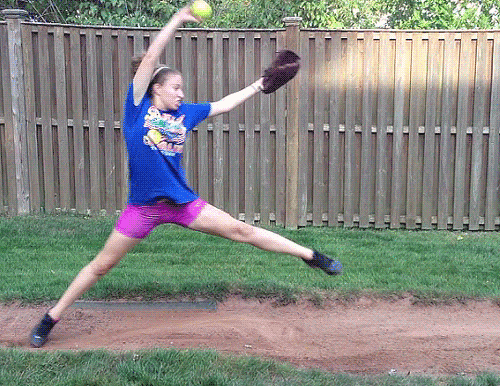
The back of the hand turns to face the catcher and then you flip your wrist forward.
The change in hand position happens as you approach the throw zone. Notice that the pitcher in the example is still in fastball position as her hand comes over the top of the circle. Then, to simplify it into three steps:
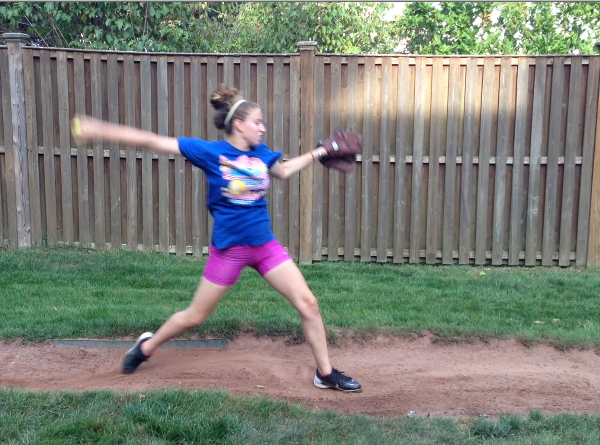
Instead of falling into a palm-up position, the ball faces down
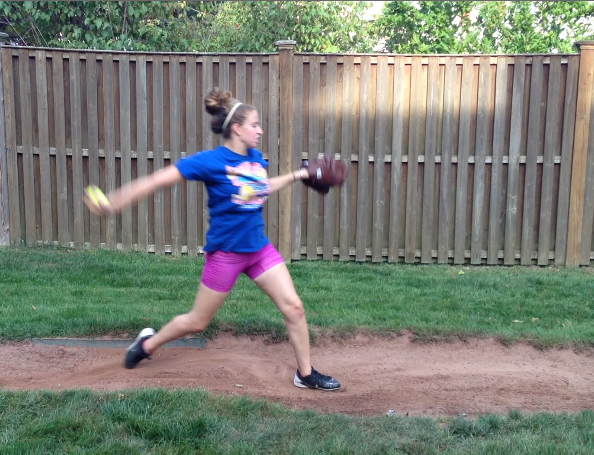
The hand continues to turn over, with the back of the hand facing the ground and the elbow facing the sky
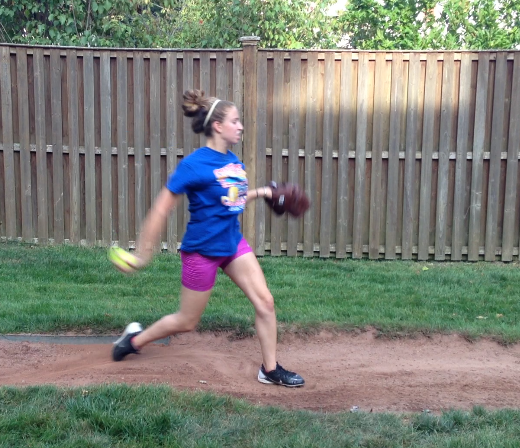
The arm relaxes and the back of the hand aims toward the catcher, preparing for the flip.
The backwards spin also enables you to throw a slow pitch while moving your arm very fast.
i watched my DD’s c/u and told her to rotate her hand position as she approached the throw zone… exactly as you described it. thanks for confirming it.
btw, the ‘drag’ of the pitcher above is similar to my DD’s drag except that she does have a tendency to flatten her pivot foot somewhere in the middle of the drag, however, it doesn’t totally go flat as in scraping the ground and rebounds back vertical towards the end. need to work on keeping that pivot foot more ‘vertical’. any tips?
TIA
Check out the drive-through stuff here: https://www.fastpitchpower.com/perfecting-your-drive-through-mechanics/
She needs to work on aiming her shoelaces at the catcher rather than leading with her heel, but that’s easier said than done.
carly,
i’ll read up on that and ask dd to read that article as well.
tnx
jordan
Carly,
Question about the flip change. You state above: “The flip change is kind of like an opposite fastball; it spins with 4-seam rotation backwards as it’s floating forward. You can hold it like your fastball.”
Does this mean you grip it like the fastball instead of putting deep into your palm?
Thanks
John
Hi John,
Yes, you grip it in your fingertips like a fastball, not deep in your palm
My daughter still leans forward while theowing flip. She also uses her arm too much, instead of her wrist, I believe. Any advice on how to stop this? Thanks!
Hi Liz,
Since I think everyone can benefit from this answer, I addressed your question here: https://www.fastpitchpower.com/change-trouble/
Hello Carly,
My 10U daughter is learning the flip & the palm but I’m curious of your thoughts on if you think one is better than the other as far as ease of perfecting or consistency. Do you feel there are advantages or disadvantages of one over the other? Is the flip more difficult to perfect for a young pitcher and if so is there an advantage to learning both or should she stick with perfecting one? Seems to me the palm would be easier to learn and more consistent given it has less mechanical movements of the wrist/arm but not sure. Thank you.
/Steve
Hi Steve,
Sorry for the late response. I’d really like to address this in detail in a blog post because it’s a great question! The short answer is both pitches are effective and which one is better depends entirely on the individual pitcher. If there’s one she’s having an easier time with, I’d focus on that one for now. But I will write more on this subject as soon as I have a chance!
Hello Carly. My Daughters C/U is loopy. How can She minimize her loop in the Palm Change. Thanks